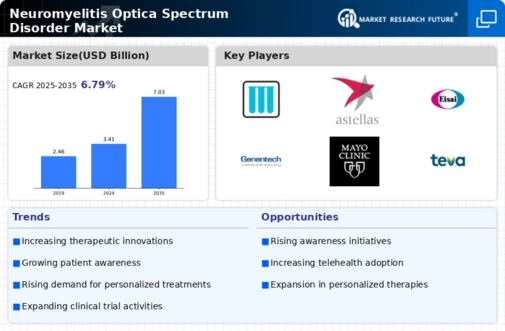Emergence of Personalized Medicine
The emergence of personalized medicine is reshaping the Neuromyelitis Optica Spectrum Disorder Market. Tailoring treatment approaches to individual patient profiles is becoming increasingly feasible due to advancements in genetic and molecular research. This shift towards personalized therapies is particularly relevant for NMOSD, where patient responses to treatment can vary significantly. By focusing on the unique characteristics of each patient, healthcare providers can optimize treatment efficacy and minimize adverse effects. As personalized medicine continues to gain traction, it is expected to drive demand for specialized therapies in the NMOSD market, ultimately enhancing patient care and outcomes.
Advancements in Diagnostic Techniques
Advancements in diagnostic techniques for Neuromyelitis Optica Spectrum Disorder Market are significantly influencing the Neuromyelitis Optica Spectrum Disorder Market. Enhanced imaging technologies, such as MRI and the identification of specific biomarkers, have improved the accuracy of NMOSD diagnosis. These innovations facilitate earlier detection and intervention, which is crucial for managing the disease effectively. As diagnostic capabilities improve, more patients are likely to be diagnosed, leading to an increased demand for treatment options. Furthermore, the development of standardized diagnostic criteria is expected to streamline the identification of NMOSD, thereby fostering a more robust market environment for therapeutic solutions.
Increased Collaboration Among Stakeholders
Increased collaboration among stakeholders in the Neuromyelitis Optica Spectrum Disorder Market is fostering innovation and growth. Pharmaceutical companies, academic institutions, and patient advocacy groups are forming partnerships to share knowledge and resources. This collaborative approach is essential for addressing the complexities of NMOSD and developing effective treatment strategies. By pooling expertise, stakeholders can expedite the research and development process, leading to the introduction of new therapies. Additionally, these collaborations often result in comprehensive educational initiatives aimed at raising awareness about NMOSD, which can further stimulate market demand as more patients seek diagnosis and treatment.
Growing Investment in Neurological Research
The growing investment in neurological research is a critical driver for the Neuromyelitis Optica Spectrum Disorder Market. Governments and private organizations are increasingly allocating funds to explore the underlying mechanisms of NMOSD and to develop novel therapeutic approaches. This influx of capital is likely to accelerate the pace of clinical trials and the introduction of new drugs into the market. For instance, recent funding initiatives have focused on understanding the autoimmune aspects of NMOSD, which could lead to breakthroughs in treatment. As research continues to evolve, the market is expected to benefit from a wider array of therapeutic options, enhancing patient outcomes and driving market expansion.
Rising Incidence of Neuromyelitis Optica Spectrum Disorder
The increasing incidence of Neuromyelitis Optica Spectrum Disorder Market (NMOSD) is a pivotal driver for the Neuromyelitis Optica Spectrum Disorder Market. Recent studies indicate that the prevalence of NMOSD is on the rise, with estimates suggesting that it affects approximately 4 to 10 individuals per 100,000 people. This growing patient population necessitates the development of targeted therapies and management strategies, thereby propelling market growth. As awareness of NMOSD expands among healthcare professionals and patients, the demand for effective treatment options is likely to increase. Consequently, pharmaceutical companies are investing in research and development to address this unmet medical need, which could lead to a surge in innovative therapies entering the market.


















Leave a Comment